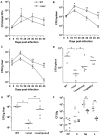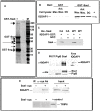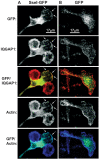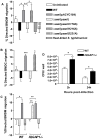The Salmonella SPI2 effector SseI mediates long-term systemic infection by modulating host cell migration
- PMID: 19956712
- PMCID: PMC2777311
- DOI: 10.1371/journal.ppat.1000671
The Salmonella SPI2 effector SseI mediates long-term systemic infection by modulating host cell migration
Abstract
Host-adapted strains of Salmonella enterica cause systemic infections and have the ability to persist systemically for long periods of time despite the presence of a robust immune response. Chronically infected hosts are asymptomatic and transmit disease to naïve hosts via fecal shedding of bacteria, thereby serving as a critical reservoir for disease. We show that the bacterial effector protein SseI (also called SrfH), which is translocated into host cells by the Salmonella Pathogenicity Island 2 (SPI2) type III secretion system (T3SS), is required for Salmonella typhimurium to maintain a long-term chronic systemic infection in mice. SseI inhibits normal cell migration of primary macrophages and dendritic cells (DC) in vitro, and such inhibition requires the host factor IQ motif containing GTPase activating protein 1 (IQGAP1), an important regulator of cell migration. SseI binds directly to IQGAP1 and co-localizes with this factor at the cell periphery. The C-terminal domain of SseI is similar to PMT/ToxA, a bacterial toxin that contains a cysteine residue (C1165) that is critical for activity. Mutation of the corresponding residue in SseI (C178A) eliminates SseI function in vitro and in vivo, but not binding to IQGAP1. In addition, infection with wild-type (WT) S. typhimurium suppressed DC migration to the spleen in vivo in an SseI-dependent manner. Correspondingly, examination of spleens from mice infected with WT S. typhimurium revealed fewer DC and CD4(+) T lymphocytes compared to mice infected with Delta sseI S. typhimurium. Taken together, our results demonstrate that SseI inhibits normal host cell migration, which ultimately counteracts the ability of the host to clear systemic bacteria.
Conflict of interest statement
The authors have declared that no competing interests exist.
Figures








Similar articles
-
A naturally occurring single nucleotide polymorphism in the Salmonella SPI-2 type III effector srfH/sseI controls early extraintestinal dissemination.PLoS One. 2012;7(9):e45245. doi: 10.1371/journal.pone.0045245. Epub 2012 Sep 18. PLoS One. 2012. PMID: 23028876 Free PMC article.
-
Salmonella Typhimurium effector SseI inhibits chemotaxis and increases host cell survival by deamidation of heterotrimeric Gi proteins.PLoS Pathog. 2018 Aug 13;14(8):e1007248. doi: 10.1371/journal.ppat.1007248. eCollection 2018 Aug. PLoS Pathog. 2018. PMID: 30102745 Free PMC article.
-
Functional analysis of the Salmonella pathogenicity island 2-mediated inhibition of antigen presentation in dendritic cells.Infect Immun. 2008 Nov;76(11):4924-33. doi: 10.1128/IAI.00531-08. Epub 2008 Sep 2. Infect Immun. 2008. PMID: 18765734 Free PMC article.
-
Salmonella's long-term relationship with its host.FEMS Microbiol Rev. 2012 May;36(3):600-15. doi: 10.1111/j.1574-6976.2012.00332.x. Epub 2012 Mar 9. FEMS Microbiol Rev. 2012. PMID: 22335190 Review.
-
Salmonella persistence and transmission strategies.Curr Opin Microbiol. 2012 Feb;15(1):100-7. doi: 10.1016/j.mib.2011.10.013. Epub 2011 Dec 1. Curr Opin Microbiol. 2012. PMID: 22137596 Review.
Cited by
-
Identification and characterization of novel Salmonella mobile elements involved in the dissemination of genes linked to virulence and transmission.PLoS One. 2012;7(7):e41247. doi: 10.1371/journal.pone.0041247. Epub 2012 Jul 20. PLoS One. 2012. PMID: 22911766 Free PMC article.
-
Oral Administration of Lactobacillus rhamnosus GG Ameliorates Salmonella Infantis-Induced Inflammation in a Pig Model via Activation of the IL-22BP/IL-22/STAT3 Pathway.Front Cell Infect Microbiol. 2017 Jul 18;7:323. doi: 10.3389/fcimb.2017.00323. eCollection 2017. Front Cell Infect Microbiol. 2017. PMID: 28770173 Free PMC article.
-
Salmonella typhimurium impedes innate immunity with a mast-cell-suppressing protein tyrosine phosphatase, SptP.Immunity. 2013 Dec 12;39(6):1108-20. doi: 10.1016/j.immuni.2013.11.009. Immunity. 2013. PMID: 24332031 Free PMC article.
-
Subcellular targeting of Salmonella virulence proteins by host-mediated S-palmitoylation.Cell Host Microbe. 2011 Jul 21;10(1):9-20. doi: 10.1016/j.chom.2011.06.003. Cell Host Microbe. 2011. PMID: 21767808 Free PMC article.
-
Association of Salmonella virulence factor alleles with intestinal and invasive serovars.BMC Genomics. 2019 May 28;20(1):429. doi: 10.1186/s12864-019-5809-8. BMC Genomics. 2019. PMID: 31138114 Free PMC article.
References
-
- Gordon MA, Graham SM, Walsh AL, Wilson L, Phiri A, et al. Epidemics of invasive Salmonella enterica serovar enteritidis and S. enterica Serovar typhimurium infection associated with multidrug resistance among adults and children in Malawi. Clin Infect Dis. 2008;46:963–969. - PubMed
-
- Kariuki S, Revathi G, Kariuki N, Kiiru J, Mwituria J, et al. Invasive multidrug-resistant non-typhoidal Salmonella infections in Africa: zoonotic or anthroponotic transmission? J Med Microbiol. 2006;55:585–591. - PubMed
-
- Sigauque B, Roca A, Mandomando I, Morais L, Quinto L, et al. Community-acquired bacteremia among children admitted to a rural hospital in Mozambique. Pediatr Infect Dis J. 2009;28:108–113. - PubMed
-
- Yen YF, Wang FD, Chiou CS, Chen YY, Lin ML, et al. Prognostic Factors and Clinical Features of Non-typhoid Salmonella Bacteremia in Adults. J Chin Med Assoc. 2009;72:408–413. - PubMed
Publication types
MeSH terms
Substances
Grants and funding
LinkOut - more resources
Full Text Sources
Other Literature Sources
Medical
Molecular Biology Databases
Research Materials
Miscellaneous

